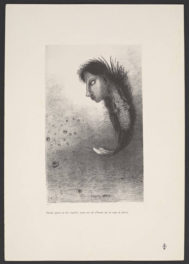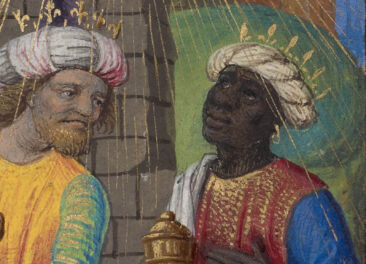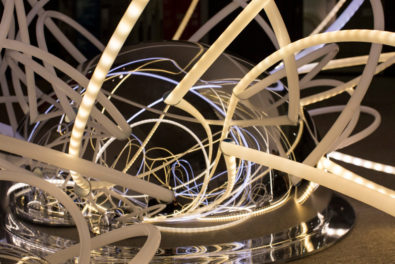
University of Arizona staff at the inspection and authentication of the recovered de Kooning painting. Woman-Ochre, 1954–55, Willem de Kooning. Oil on canvas, 30 x 40 in. Artwork © 2019 The Willem de Kooning Foundation / Artists Rights Society (ARS), New York. Photo: Bob Demers/UANews
Willem de Kooning was one of the pioneers and leaders of the abstract expressionist movement, which began in New York after World War II. In 1950 he began his best-known body of work, the Woman series. Heavily influenced by Picasso, the series is considered monumental in the way it imagines the human figure.
A painting in the series, Woman-Ochre (1954–55), was gifted to the University of Arizona Museum of Art (UAMA) in 1958 by collector Edward Joseph Gallagher, Jr. It was regularly exhibited at UAMA and loaned to important exhibitions on de Kooning and related artists at major museums in the United States.

Woman-Ochre in August 2017, shortly after it was recovered in New Mexico and returned to the University of Arizona Museum of Art. Woman-Ochre, 1954–55, Willem de Kooning. Oil on canvas, 30 x 40 in. © 2019 The Willem de Kooning Foundation / Artists Rights Society (ARS), New York
The Theft
On the day after Thanksgiving 1985, Woman-Ochre was stolen from the university museum. That morning, a man and a woman followed a museum staff member inside when the museum opened. The woman distracted a security guard while the man went upstairs and cut Woman-Ochre from its frame, ripping the canvas off its backing and rolling it up to conceal it. The two hurried out of the museum and never returned. They were in the museum for less than 15 minutes.
Return of a Painting
The painting remained missing for more than thirty years until August 2017, when antiques dealer David Van Auker purchased a group of furniture and art, including the painting, at a posthumous estate sale of an Arizona couple. While the painting was on display in his New Mexico store, several customers commented on its resemblance to de Kooning’s work, prompting Van Auker to research the artist and connect his purchased painting with the 1985 theft. Van Auker contacted UAMA staff, who traveled to New Mexico to retrieve the painting and bring it back to the museum in Tucson. Despite the painting’s discovery, the theft has not been solved; the FBI investigation into who stole the painting is ongoing.
Once the painting was returned to the museum, conservators were able to examine it carefully and match it to the remnants of the cut canvas they had preserved after the robbery, confirming the painting was in fact Woman-Ochre. Badly damaged during the theft and from its decades-long disappearance, the painting now needs professional care.
The video below, from the University of Arizona, provides a look behind the scenes at the return, examination, and identification of the stolen painting.
The Conservation Project
Through an agreement with the University of Arizona, conservators at the Getty Museum and scientists at the Getty Conservation Institute will work together to study, repair, clean, conserve, and document the painting. This work will include reuniting it with the original frame as well as repairing and restoring remnants of the canvas that were left behind after the theft and retained by the UAMA since 1985.

University of Arizona staff at the inspection and authentication of the recovered de Kooning painting. Woman-Ochre, 1954–55, Willem de Kooning. Oil on canvas, 30 x 40 in. Artwork © 2019 The Willem de Kooning Foundation / Artists Rights Society (ARS), New York. Photo: Bob Demers/UANews
The Getty is well versed in the work of de Kooning, whose idiosyncratic working methods have created intense speculation and debate among conservators and art historians, primarily from visual inspection and anecdotal accounts rather than rigorous technical analysis. In 2010, the Conservation Institute worked closely with Susan Lake, then head of collection management and chief conservator at the Hirshhorn Museum and Sculpture Garden in Washington D.C., on an in-depth study of de Kooning’s paintings from the 1940s through the 1970s, published by the Getty as Willem de Kooning: The Artist’s Materials.
The Getty-University of Arizona project will also be a teaching tool, providing access and information to graduate-level conservation and science students at local universities as well as those from the University of Arizona.
On View at the Getty
The project begins in April 2019 and is expected to take approximately a year and half. In summer 2020, the painting will go on view temporarily at the Getty Museum before returning to its home at the UA Museum of Art.




Comments on this post are now closed.